Had they scored a touchdown on the last drive, the Bills would have won the game, giving the Chiefs almost nothing to work with. At least that was the plan.

buffalonews.com
Overview
Josh Allen’s performance grade against Kansas City in the AFC divisional playoff was 92% as he completed 26 of 39 attempts (67%) for 186 yards and one touchdown. On the ground, Allen was dangerous and productive, rushing for 72 yards on 12 carries and scoring two touchdowns. He also had a fumble. Allen was highly efficient and willing to check the ball down quickly and decisively against zone coverage as his progressions down the field were covered. Allen’s leadership, his poise and his physicality were all deserving of an opportunity to continue the Bills’ playoff journey.
Interim offensive coordinator Joe Brady played his hand as well as it could have been played, maximizing and focusing on a strong running game. This took the wind out of the sails of the Chiefs’ defense for most of the game, as the Bills’ offense controlled the time of possession, 37:03 to 22:57, on a total of eight possessions. The Bills’ offense ran 31 more plays and racked up 182 yards rushing compared to 146 yards for the Chiefs. The Bills’ offense statistically outdueled the Chiefs’ on third downs, converting 7 of 14 compared to 1 of 5. The problem however, was the effectiveness of each play. On the ground, the Chiefs averaged 6.1 yards per rush to the Bills' 4.7. Through the air, the Chiefs averaged 9.2 yards per pass play to the Bills' 4.8 yards.
In my opinion, the offensive game plan was spot on. Heading into the game, the Bills’ offense knew it needed to possess the football and score, neutralizing the Chiefs’ ability to attack an injury-riddled defense that simply could not hold up any longer. The calculation and the execution that it took to put the ball in Allen’s hands, on perhaps the final drive with 8:23 remaining and a three-point deficit was perhaps what head coach Sean McDermott had dreamed of. It was the best case scenario as the Bills drained the clock, systematically progressing down the field into scoring position. Had they scored a touchdown on the last drive, the Bills would have won the game, giving the Chiefs almost nothing to work with.
At least that was the plan.
First quarter
Play selection: 21 plays: Nine passes, 12 runs.
Allen: 7 for 9 passing for 51 yards. Four carries for 21 yards.
Performance grade: 100%.
Score: Bills, 7-6.
The Chiefs deferred after winning the toss and the Bills received. The first drive, as seemed to happen in Bills’ games this season, began with a hiccup on the first play. Allen threw a quick pass to wide receiver Stefon Diggs on a bubble screen and Diggs was stripped by safety Chamarri Conner. Tight end Dalton Kincaid knocked the loose ball out of bounds. It was a penalty for illegal batting, but the Bills retained possession, after a loss of seven yards and loss of down.
On second-and-17, Allen threw a strike to Diggs on a dig route that he was not able to bring in. Diggs rounded his route and drifted toward the safety. This was not the design as he was supposed to be more flat, coming back toward Allen. This was a poor start for Diggs, both protecting the football and executing.
This created a desperate third-and-17. Allen answered with a remarkable lateral.
Allen stepped up in the pocket as the Chiefs dropped back into quarter-quarter-half zone and looked to run. He had the presence of mind to understand that he could get the ball to his check down back, Ty Johnson, as long as the ball was thrown backward. This play kept this drive alive, and the Bills kicked a field goal 10 plays later.
It is notable that on this drive, James Cook also appeared to fumble but was ruled down. Clearly, the Chiefs were focused on trying to create a turnover.
Allen tush-pushed on fourth-and-1 and completed 5 of 7 attempts on this 13-play drive, which gave the Bills an early lead, overcoming the hole Diggs’ fumble created.
Here is a look at the third-and-8 play that was deflected at the line of scrimmage by Chris Jones. The Chiefs rushed only one defensive lineman and spied Allen to the left, the direction the rush was designed for and dropped everyone else into the end zone.
Notice how the Chiefs led two of the three Bills receivers, Diggs and Trent Sherfield, into each other. They didn’t get clean releases, which reduced the effectiveness of the routes down the field. Also, the Chiefs only rushed one player, George Karlaftis (No. 56) to Allen’s right, presumably to encourage Allen to escape left. This calculation was a trap that had spy Willie Gay (No. 50), boxed in red, waiting for Allen on the left.
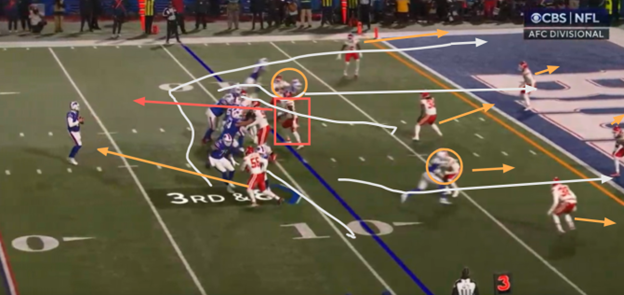
Allen stayed in the pocket and tried to check down to running back Latavius Murray, but it was knocked down by Jones, who was not rushing, instead trying to get into the throwing lane of Allen’s short options.
It’s not clear what Brady was trying to achieve in the end zone with the three receivers, but the Chiefs had it covered, bracketed and smothered with no chance of success. The Bills were anticipating blitz, but instead the Chiefs rushed one and dropped seven into zone coverage. The Bills kicked the field goal to take the early lead.
The Chiefs answered with a 47-yard field goal to tie the game 3-3.
Allen and the Bills’ offense began their second offensive series with 4:35 in the quarter. Brady kept the Chiefs off balance by moving Cook from one side of Allen to the other just before the snap, with the use of a sixth offensive lineman, and with 3 by 1 formations.
On the third play of this drive, Brady called this throwback concept.
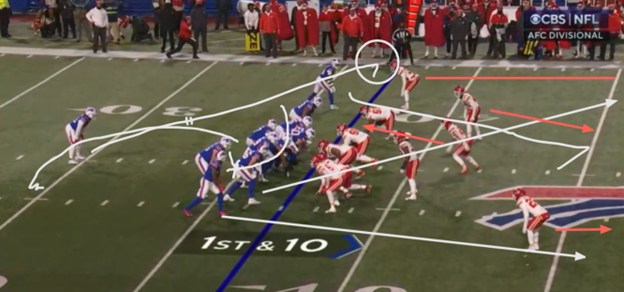
Here, the sixth offensive lineman, David Edwards (No. 76), lined up to the left of Allen and then shifted to the right to create a trips or three-receiver set to the right. This caused the Chiefs’ linebackers to re-adjust their positions. The play action went to the weak side, and as Allen set up for the pass, Johnson, the running back who Allen faked to, leaked into the flat uncovered. Allen did a terrific job of progressing quickly, identifying that Diggs and Kincaid were accounted for in coverage and getting the football out to his back. The Bills got a first down and had a first-and-10 past midfield.
Allen played as well as he possibly could have in the first quarter, completing 7 of 9 attempts, protecting the football, and being as efficient as possible.
Second quarter
Play selection: 20 plays: 10 passes, 10 runs.
Allen: 7 for 10 passing for 60 yards, touchdown. Four carries for 18 yards.
Performance grade: 100%.
Score: Bills, 17-13.
Three plays into the second quarter, Allen scored a go-ahead touchdown on this run.
Here, on second-and-3 from the 5-yard line, Brady called a quarterback counter using Edwards again as the sixth offensive lineman, countering to Allen’s left.
Allen recognized the Chiefs were in man-to-man coverage, and rather than run up inside of Edwards' block – where they had an extra defender that could not be accounted for – he spilled his run to the outside. This was tremendous awareness and Allen walked into the end zone untouched. Brady called nine runs and two passes in 11 total plays, and the Bills used 3 x 1 formations almost exclusively, while adding the sixth offensive lineman.

The Chiefs answered with another field goal to close the gap to 10-6.
The Bills punted on the next possession as this second-and-8 attempt on a go route by Sherfield was missed.
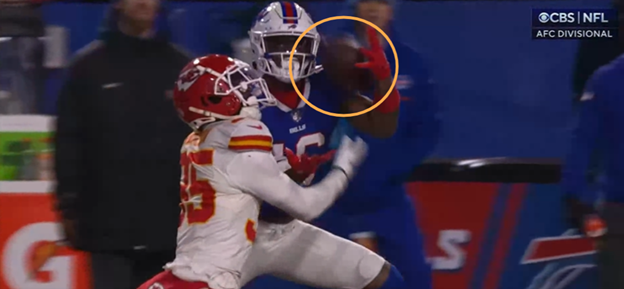
Allen recognized man-to-man on Sherfield and took a shot to his left. The ball was perfectly thrown, but Sherfield was not able to bring it in. This created a third-and-8 and the Chiefs blitzed and were able to rally to tackle on a short completion to Khalil Shakir.
Bills punter Sam Martin, who was injured last week having pulled his left hamstring, punted very poorly on this attempt. Generally, with the Bills punting from their own 40-yard line, an NFL punter would be capable of pinning the opponent inside of their 10-yard line. Martin’s punt was lined low and directly to the punt returner, Richie James, who fielded it on his 20-yard line and returned it 15 yards.
The Chiefs’ offense took the lead with an impressive five-play touchdown scoring drive to take their first lead of the game at 13-10. The Bills’ defense busted a coverage that allowed tight end Travis Kelce to be uncovered for an uncontested 22-yard touchdown pass.
Allen and the Bills’ offense had another chance before halftime with a final drive, beginning on the Bills’ 25-yard line with three minutes remaining. On the fifth play, Allen completed his fourth consecutive pass, this one to Murray.

Next, Allen scrambled for 18 yards, ran another quarterback-designed run, completed a third-and-5 pass, and finally hammered into the end zone for the halftime lead.
Brady emptied the backfield here and pulled center Mitch Morse to influence the defensive momentum to the left. Allen’s eyes went left as well, making it appear as if he were throwing the football quickly to his left. This was a setup for Allen to run back to his right.
As you watch the video, watch Allen’s ferocity as he puts his head down and impressively drives himself across the goal line. Offensive linemen O’Cyrus Torrence, Spencer Brown and Conner McGovern all surged with Allen into the end zone.

The Bills took the lead into halftime 17-13 as Allen played a perfect first half of football. His two rushing touchdowns were the difference as he completed 14 of 19 for 111 yards while rushing for 52 yards.
Third quarter
Play selection: 15 plays: Six passes, nine runs.
Allen: 5 for 6 passing for 31 yards and one touchdown. One carry for 3 yards.
Performance grade: 93%.
Score: Bills, 24-20.
The Chiefs took their opening second-half possession down the field for a touchdown to take a 20-17 lead.
Allen and the Bills began their fifth offensive possession with 11:48 in the third quarter. The point of limiting possessions with ball control was working to keep the Chiefs’ offense off the field. Conversely, it also was limiting offensive opportunities, making each possession so much more valuable.
Brady called a masterful, 15-play drive that included nine runs and six passes, as Allen completed 5 of 6 attempts. His only incompletion was a throwaway.
On third-and-goal, from the Chiefs’ 13-yard line, following a delay of game penalty, Allen made this remarkable touchdown pass to Shakir.
Here, the Chiefs used the same strategy as the first half. They dropped seven defenders into coverage while rushing only three with the intent to force Allen to flush out to his left. Seeing this again, it was a clear strategy to try to gain a tactical advantage on Allen who, as a righthanded quarterback, naturally wants to roll to his right. The other planned element was to always collision Diggs, no matter where he was, and to have a spy for Allen. In this case, the spy was Leo Chanel (No. 54).

Despite these challenges, Allen rolled to his left, and under duress was still capable of putting the ball in a location where only Shakir could catch it.
This ball placement on the front pylon was absolutely perfect. The results on this drive were significant as the Bills drained more than eight minutes off the clock, took the lead at 24-20, and gained momentum.

At this point, Allen had only one minus in our grading system from taking a delay of game penalty.
Fourth quarter
Play selection: 21 plays: 14 passes, eight runs.
Allen: 7 for 14 passing for 44 yards. Three carries for 8 yards.
Performance grade: 76%.
Score: Chiefs, 27-24.
The Chiefs took the lead again with a touchdown early in the fourth quarter for the fifth lead change in six possessions.
Allen took over on his sixth offensive possession with the Bills trailing by three points with 11 minutes remaining. The first play was a quarterback run for an 8-yard gain. On second-and-2, Cook was stuffed in the backfield to force third-and-5.
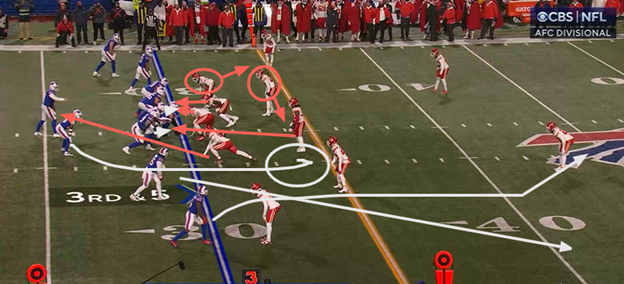
Here, the Chiefs overloaded and ran a zone blitz, overloading Allen’s right side. Right tackle Brown protected the blitz from Nick Bolton (No. 32), which turned Karlaftis (No. 56) loose to Allen.
Brady tried to get cute again, lining Diggs up in the backfield. The Chiefs didn’t care, their intent was to overload the right side of the line. Allen had Diggs but could not get the ball to him because Karlaftis deflected the pass.
The Bills were not able to have the same success on the ground as they had in the first half and were forced to punt.
The Chiefs had only 10 players on the field and a fake punt was called from the sideline. The problem was that this fake punt was very poorly blocked and it was orchestrated from the Bills’ own 30-yard line.
This blunder was returned back to the Bills on the ensuing drive as the Chiefs fumbled what was nearly a touchdown out of the endzone. This touchback negated the muffed fake punt and gave the Bills another opportunity.
This next possession was again unsuccessful as Cook was stuffed on first-and-10 for a 4-yard loss. Then on second-and-14, Allen completed a short pass to Shakir, who was injured on the play. On third-and-12, Allen launched a long pass to Sherfield who again could not make the catch on the deep attempt. The Bills went three-and-out for the second consecutive drive.
Credit the Chiefs’ defense for bringing one more defender down to the line of scrimmage than the Bills could block. They were shooting gaps, getting penetration and filling cutback lanes. Allen also seemed to begin to press as the long throw to Sherfield seemed like a stretch.
The Chiefs’ strategy remained the same. They rushed three on third-and-12, spied Allen and dropped seven defenders into deep quarters coverage.
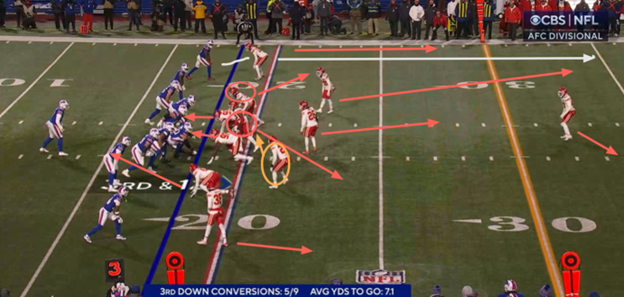
Notice the wide rusher to Allen’s right, also tactically designed to push Allen left and into the spy circled in yellow. Allen had time in the pocket, but his patience was running low as he felt the need to try to push the ball down the field.
The Bills’ punt was again shanked by an injured Martin, which makes one wonder if it was the right decision to dress him in favor of newly signed Matt Haack, who was at least healthy. The poor punt barely made it past midfield in the air and resulted in more great field position for the Chiefs’ offense on their own 43-yard line with a three-point lead.
The Bills’ defense held with a valiant effort and forced a punt that would give Allen and the Bills one final opportunity to win.
Allen took over with 8:23 remaining on only his eighth possession of the game. The Bills took over from their own 20-yard line, and on the very first play Allen took a long shot to Diggs. Allen threw this ball from his own 16-yard line and it was missed by Diggs on the 27-yard line of the Chiefs.
It was perfectly thrown over the top of the defenders. Had Diggs made this catch, he would have scored and given the Bills a four-point lead.
As the drive continued, Allen scrambled on a third-and-10 and fumbled the football, but Kincaid batted it and Brown recovered. This forced a fourth-and-3 from midfield with four minutes to play.
This was a brilliant play call by Brady in this situation, anticipating man-to-man coverage. Trent McDuffie (No. 22) was defending Shakir. The magic here was the unique motion by Shakir to start on the right, then cross the formation, then loop back behind Allen and then turn around and go the other way. The motion had McDuffie bamboozled and this was an easy throw into the flat for the first down.

As time wound down to less than two minutes, Allen made two decisions that resulted in the need for a field goal attempt. As well as he played, and as dynamic a player that he is, he had opportunities here that he passed on.
On second-and-9, from an empty formation, Allen went for it all, rather than going through his progressions and taking Diggs on an open crossing route.
Here, Allen miscalculated that Shakir could get over the top of the circled defender. Had he thrown the football to Diggs, it could have been at least a huge gain, maybe a touchdown.

On the next play, Brady wanted to give Allen one side to look at, and so he lined up in a trips-bunch formation to Allen's left. Both Shakir and Kincaid ran short pivot routes, meaning they first went outside and then swiveled back to the inside.
Allen knew that he had both Kincaid or Shakir for a completion underneath. Rather than work to deliver to Shakir, he pulled the ball down and tried to improvise. Once he was out of the pocket, he threw it away.

Had Allen taken the underneath opportunities on either of these two plays at the end, the Bills might have been closer to a field goal attempt, could have achieved another first down, or had a choice to make on a fourth-and-short.
The result was a field goal attempt to tie the game. I have to believe that had the Bills been in fourth-and-short, they would have gone for it and perhaps had the outcome they deserved.
Conclusion
This was a heartbreaking loss for a team and a quarterback in Allen that has endured so much this season. This game came down to just a few plays that offensively, done differently, could have changed the outcome. The effort and the drive was there. Offensively, at the end of this game, the Bills had exactly what they were hoping for, control of the last possession to win the game. But this final sequence was a bit out of system. This is not a criticism, it is just a fact. It is curious that the struggle to get the ball to Diggs, to get him touches, to get him involved, might in some ways have hindered the offensive philosophy.
Allen is an extraordinary talent. Allen’s incomparable ability needs to be shaped into an iron rod of belief in the system, in how to play to win championships, and with a supporting cast of players, some of whom are already on the roster.
Having had the privilege of grading every professional game of Allen’s tremendous career, I am confident he is the man who can make this into a Super Bowl story and once and for all extinguish the demons of the past. He can shape his beliefs and Billieve, but he cannot do it alone and McDermott and General Manager Brandon Beane must add the right pieces to this unfinished puzzle of talent.

















 Josh Allen
Josh Allen Spencer Brown
Spencer Brown Mitch Morse
Mitch Morse Khalil Shakir
Khalil Shakir Dion Dawkins
Dion Dawkins O’Cyrus Torrence
O’Cyrus Torrence Greg Rousseau
Greg Rousseau A.J. Epenesa
A.J. Epenesa James Cook
James Cook Ty Johnson
Ty Johnson David Edwards
David Edwards Von Miller
Von Miller Dalton Kincaid
Dalton Kincaid Dawson Knox
Dawson Knox Stefon Diggs
Stefon Diggs Leonard Floyd
Leonard Floyd Tyrel Dodson
Tyrel Dodson Taron Johnson
Taron Johnson Dane Jackson
Dane Jackson Trent Sherfield
Trent Sherfield Ed Oliver
Ed Oliver DaQuan Jones
DaQuan Jones Connor McGovern
Connor McGovern Rasul Douglas
Rasul Douglas Micah Hyde
Micah Hyde Jordan Poyer
Jordan Poyer Shaq Lawson
Shaq Lawson A.J. Klein
A.J. Klein Matt Milano
Matt Milano Christian Benford
Christian Benford Gabe Davis
Gabe Davis Quintin Morris
Quintin Morris Terrel Bernard
Terrel Bernard Latavius Murray
Latavius Murray Dorian Williams
Dorian Williams Taylor Rapp
Taylor Rapp Tim Settle
Tim Settle Jordan Phillips
Jordan Phillips Kaiir Elam
Kaiir Elam